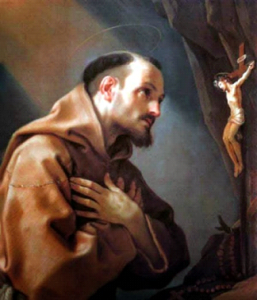 Saint Bonaventura
Saint Bonaventura
Cardinal-Bishop, Doctor of the Church († 1274)
Feast – July 14
Born at Bagnoregio in Umbria, part of the Papal States in 1221, his parents were Giovanni di Fidanza and Maria di Ritella. It seems that his father was a physician and a man of means. This frail child was given the name of John at his baptism. He soon fell so ill that his cure was despaired of, and his sorrowing mother had recourse to Saint Francis, recognized everywhere in Italy as a Saint. She promised God she would endeavor to have the child take the habit of the Franciscan Order, if he were cured. Her prayer was granted, the child was cured, and Saint Francis himself gave him his new name. In reference to the miraculous cure, he prophetically exclaimed of the infant, O buona ventura!— O good fortune! Saint Francis died about five years later, not without foreseeing the future of this little one, destined to be a seraph of love like himself.
St. Bonaventura played an important role in both the medieval Church and the history of the Franciscan Order which he entered in 1243. Was sent from the Roman Province, to which he belonged, to complete his studies at the University of Paris under Alexander of Hales, the great founder of the Franciscan School and received in 1248 the “licentiate” which gave him the right to teach publicly as a Magister regens. In 1253 he held the Franciscan chair at Paris. Sanctity and learning raised St. Bonaventura to the Church’s highest honors, yet at heart he was ever the poor Franciscan friar, who practiced and taught humility and mortification. He was the friend of St. Thomas Aquinas; they received the Doctor’s cap together in Paris. St. Thomas asked him one day from what source he drew his great learning; he replied by pointing to his crucifix. Another time St. Thomas found him in ecstasy while writing the life of Saint Francis. The Angelic Doctor said, while retiring quietly, “Let us leave a Saint in peace, to write of a Saint!” A senior faculty member at the University of Paris, St. Bonaventura certainly captured the hearts of his students through his academic skills and insights, but more importantly, he captured their hearts through his Franciscan love for Jesus and the Church. Like his model, Saint Francis, Jesus was the center of everything—his teaching, his administration, his writing, and his life. So much so, that he was given the title “Seraphic Doctor.”
St. Bonaventura’s teaching career came to a halt when after having successfully defended his order against the reproaches of the anti-mendicant party, at the age of thirty-six, the Friars elected him to serve as Minister General of the Franciscan Order. On 24 November 1265, he was selected for the post of Archbishop of York, by the din of tears and entreaties to the Holy Father Clement IV he was never consecrated and resigned the appointment in October 1266.
His 17 years of service were not easy as the Order was embroiled in conflicts. As a man of prayer and a good administrator, Saint Bonaventura managed to structure the Order through effective legislation and offered the Friars an organized spirituality based on the vision and insights of Saint Francis. Always a Franciscan at heart and a mystical writer, Bonaventura managed to unite the pastoral, practical aspects of life with the doctrines of the Church. Thus, there is a noticeable warmth to his teachings and writings that make him very appealing. St. Bonaventura left behind a structured and renewed Franciscan Order and a body of work all of which glorifies his major love—Jesus.
Shortly before he ended his service as General Minister, Pope Gregory X created him a Cardinal and appointed him bishop of Albano. St. Bonaventura quietly made his escape from Italy, and in France began to compose a book, but Pope Gregory X sent him a summons to return to Rome. On his way, he stopped to rest at a convent of his Order near Florence; and there two Papal messengers, sent to meet him with the Cardinal’s hat, found him washing the dishes. The Saint asked them to hang the hat on a nearby bush, and take a walk in the garden until he had finished what he had begun. Then taking up the hat with unfeigned sorrow, he joined the messengers, and paid them the respect due to their character. The Pope insisted on his presence at the great Second Council of Lyon in 1274.
St. Bonaventura was a guest and adviser of Saint Louis, and the director of Saint Isabella, the king’s sister. He sat at the right hand of Pope Gregory X and presided at all sessions at the Council of Lyons, assembled to provide for the reform of morals and the needs of the Holy Land, and to cement the union of the Greeks with the Roman Church, the day after its closure he died on the 15th of July, 1274, and was buried by the assembly of the Council members, still in Lyons; he was mourned by the entire Christian world.
His theology was marked by an attempt to completely integrate faith and reason. He thought of Christ as the “one true master” who offers humans knowledge that begins in faith, is developed through rational understanding, and is perfected by mystical union with God.
St. Bonaventura was formally canonized in 1484 by the Franciscan Pope Sixtus IV, and ranked along with St. Thomas Aquinas as the greatest of the Doctors of the Church by another Franciscan, Pope Sixtus V, in 1587. He was regarded as one of the greatest philosophers of the Middle Ages.
References and Excerpts
[1] F. Media, “Saint Bonaventure,” Franciscan Media, 15-Jul-2016. .
[2] “Saint Bonaventure, Cardinal-Bishop, Doctor of the Church.” [Online]. Available: http://sanctoral.com/en/saints/saint_bonaventure.html. [Accessed: 12-Jul-2019].
[3] “CATHOLIC ENCYCLOPEDIA: St. Bonaventure.” [Online]. Available: http://www.newadvent.org/cathen/02648c.htm. [Accessed: 12-Jul-2019].
[4] “Bonaventure,” Wikipedia. 01-Jul-2019.